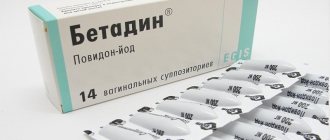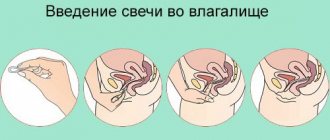Pain during menstruation has a negative impact on both the physical and mental state of a woman. To improve well-being and get rid of an unpleasant symptom, doctors recommend taking medications in different forms. Pain-relieving suppositories during menstruation are one of the most acceptable for the woman herself and at the same time an effective remedy. They allow you to quickly remove such unpleasant sensations.
Pain during menstruation plagues many girls.
What are the indications for use?
The most common indication for the use of suppositories during menstruation is the presence of inflammatory diseases.
Suppositories, both rectal and vaginal, during menstruation are used in the following cases:
- pain syndrome, spasms;
- inflammatory pathologies;
- benign tumors in the uterus, ovaries;
- adhesive process;
- inability to use medications in tablet form due to gastrointestinal diseases or allergies.
Gynecologists often prescribe suppositories to their patients for such pathologies, since they quickly eliminate pain during menstrual periods.
To whom is Diclofenac contraindicated for menstrual pain?
Diclofenac for menstrual pain is strictly prohibited for use when:
- bronchial asthma;
- diseases of the stomach/duodenum;
- severe kidney/liver pathologies;
- coronary heart disease;
- unstable blood pressure, especially if it increases frequently.
Suppositories cannot be used to relieve pain in inflammatory diseases of the large intestine and internal hemorrhoids with periodically bleeding nodes. Injections are not prescribed for metabolic disorders, problems with the blood clotting system and established alcoholism.
Doctors recommend that if you have any chronic diseases of the internal organs, you should first consult with specialists regarding the advisability of using Diclofenac to relieve menstrual pain.
What are the benefits of candles
Over the past decades, technology for the production of suppositories has greatly improved. Thanks to this, their positive qualities increased significantly. The advantages of using this dosage form include:
- Penetration of the main substance directly into the blood. The product does not enter the digestive tract.
Using candles is very convenient and effective
- The onset of the drug effect often occurs faster than when using drugs in tablet form.
- There are practically no side effects from the use of suppositories for painful periods in the form of allergic reactions.
- You don't have to take medicine that tastes bad.
- Medicines in the form of suppositories can be used by patients who are unable to swallow for one reason or another.
You can insert a suppository into the rectum or vagina area yourself, without anyone’s help. With injections, you often have to rely on the assistance of loved ones or medical personnel.
Medicinal herbs
You can relieve pain during menstruation and treat inflammation of the reproductive system with the help of medicinal herbs. They are almost as effective as tablets.
- Oregano relieves feelings of heaviness and “aching” pain. The method of use is very simple: pour 3 tablespoons of raw materials with boiling water (500 ml) and leave for half an hour. Divide the dose into three doses and take 30 minutes before meals.
- Mint-chamomile tea brewed 1:1 will not only reduce pain, but also help calm nerves and relieve depression. Painful periods will be even easier if you combine tea with a decoction of valerian root, one tablespoon of which is brought to a boil in 300 ml of boiling water.
- Nettle relieves pain and reduces heavy discharge. It can prevent anemia and put the female body in order by correcting the cycle. This unique plant restores vitamin C and iron. If you do not want to prepare a decoction yourself, purchase a plant extract (extract) at the pharmacy and take 40 drops before each meal. The duration of treatment depends on the intensity of the pain.
You don't have to endure pain during your period. Contact your doctor, who will certainly tell you the names of pills for menstrual pain. Do not forget about folk recipes, which also make a significant contribution to the fight against PMS. A timely examination by a gynecologist will prevent the development of genitourinary diseases and female problems.
Menstruation is a regular process that is accompanied by certain symptoms. Pain in the lower abdomen during menstrual periods is familiar to many women. Doctors call excessively painful periods “dysmenorrhea.”
Discomfort is increased by problems of the digestive system, dizziness, and malaise. These disorders occur in 65% of women. Dysmenorrhea is divided into primary and secondary, and each type has its own causes and methods of treatment.
What are the disadvantages
Candles also have their drawbacks. One of them is the undesirability of inserting suppositories into the vagina during menstruation, since in case of heavy discharge, the drug will come out along with it. In this case, the medicine does not have time to fully act.
Another disadvantage of suppositories is the watery base, which flows out of the rectum or vagina quite quickly.
At the same time, the woman feels some discomfort. Some representatives of the fairer sex report itching when inserting suppositories into the vagina, but such cases are quite rare.
Papaverine suppositories are often used
What are the popular pain-relieving suppositories?
The most common medications for insertion into the vagina for painful periods are included in the table.
| Name of the drug | Frequency of use | Duration of therapy |
| Ketoprofen | Apply once a day. | 2 – 5 days. |
| Naproxen | Used twice a day. | No more than four days. |
| Indomethacin | It is administered no more than three times a day at equal time intervals. | Maximum one week. |
| Betadine | Use once a day before bedtime. | The standard course of treatment is 7 days. |
The most common drug for menstrual pain is Papaverine suppositories. They are administered twice a day.
The duration of the course of therapy can range from several days to three weeks, depending on the reason why the doctor prescribed the medication.
Causes of painful periods
Primary dysmenorrhea is more common in adolescent girls and nulliparous patients. Its causes lie in heredity, poor nutrition, lack of sexual activity and its irregularity.
The condition during menstruation is worsened by several other factors:
- Avitaminosis.
- Abortion.
- Bend of the uterus.
- Underdevelopment of the genital organs.
- Hormonal disorders.
- Use of an intrauterine device.
- Postpartum period.
- Incorrect location of the internal genital organs.
Secondary dysmenorrhea develops against the background of diseases of the pelvic organs and gynecological disorders of an inflammatory nature. The pain is accompanied by copious discharge with clots.
A strong painkiller will not help here, because the pain will subside for a short time, then it will return and will cause anxiety until the end of your period.
Taking painkillers is effective only for primary dysmenorrhea. In the second case, to eliminate pain during menstruation, you must first be examined and receive an appropriate course of treatment.
What kind of suppositories are there for rectal administration?
Rectal anesthetic suppositories during menstruation are prescribed for intense pain when other medications do not cope with the syndrome. Such sensations do not arise “out of nowhere”; they are often associated with the presence of pathologies of the genitourinary system or severe inflammatory processes.
Your doctor may prescribe Tylenol
The most common medicine for administration into the rectum is Akamol-Teva. The active ingredient of the drug is paracetamol. If the use of the drug does not give the desired effect within one to two days, then its use is canceled.
Another effective drug is Tylenol.
Initially, these suppositories were used only to reduce fever. However, it later became known that they cope well with pain. The product is used up to four times a day. Read also: what medications can relieve spasms and pain.
Review of effective pills for menstrual pain relief
Let's take a closer look at each group of medications so that you understand what painkillers you can take during your period.
First, try to make yourself feel better with a warm heating pad (place it on your stomach) or hot tea with cognac or balm. Lie down in bed and take a comfortable position. If all else fails, open the first aid kit.
Nonsteroidal drugs
Drugs from the group of non-steroids suppress the inflammatory process and relieve pain. To treat dysmenorrhea, they begin to be taken 2–3 days before menstruation.
They are usually prescribed to patients who refuse hormonal medications and do not even take contraceptives. Another option is the presence of contraindications to hormonal therapy.
Non-steroidal anti-inflammatory tablets for menstrual pain may have different names:
- Paracetamol – effective for mild/moderate pain. Can be taken up to 4 times a day. Contraindications: alcohol dependence, liver and kidney pathologies.
- Ibuprofen - reduces the frequency of uterine contractions and reduces pressure in its cavity. Tablets are taken after meals 3-4 times a day. Contraindications for Ibuprofen are hemophilia, ulcer, liver or kidney failure, asthma, duodenal ulcer.
- Diclofenac - inhibits prostaglandin synthesis. Can be taken 3 times a day. Contraindications – asthma, inflammatory processes in the gastrointestinal tract, ulcers. Analogues - Rapten, Voltaren, Naklofen, Sanfinac, Diclovit.
- Naproxen – for dysmenorrhea, take twice a day. Contraindications – lactation, bronchospasms, ulcers in the digestive system. Analogues - Pronaxen, Sanaprox, Apranax, Nalgesin.
- Ketoprofen - like Diclofenac, inhibits the production of prostaglandin and affects the contractile function of the uterus. Take tablets/capsules 2 – 4 times a day. Analogues of Ketoprofen are Flamax, Dexalgin and Ketonal. Contraindications – hemophilia, ulcerative colitis, inflammatory diseases of the gastrointestinal tract, abnormal functioning of the liver and kidneys.
Despite contraindications, Ibuprofen and Paracetamol are considered the safest non-steroidal drugs. You can get rid of menstrual pain by taking combination drugs containing paracetamol and ibuprofen - Khairumat, Next, Brustan, Ibuklin.
Antispasmodics
The assortment of antispasmodics has its own painkillers for menstruation. The most famous remedy is No-shpa with drotaverine.
No-shpa Forte is taken 2 times a day, regular No-shpa - 2 - 3 times a day. If there are contraindications (lactation, lactose intolerance, pathologies of the liver, heart, kidneys), analogues are used - Unispaz, Spasmonet, Spakovin.
- Papaverine - in the absence of glaucoma, severe liver damage and heart block, tablets are taken 3 to 4 times a day.
- Halidor - the active component bencyclane has an antispasmodic and mild sedative effect. Frequency of administration: 3 times a day. Contraindications: epilepsy, hemorrhagic stroke, lactation and failure of important organs.
- Buscopan - tablets containing hyoscine butyl bromide are taken 3 times a day. Treatment is prohibited for cerebral atherosclerosis, myasthenia gravis, megacolon, glaucoma and pulmonary edema.
Side effects of antispasmodics include allergies, dizziness and migraines. Some patients complain of nausea and bowel dysfunction.
Medicines with metamizole sodium
Metamizole sodium contains medications such as:
To eliminate dysmenorrhea, tablets are taken three times a day. Doctors have established contraindications for metamizole sodium in the form of lactation, asthma, kidney and liver diseases and those pathologies that impair blood formation.
Oral contraceptives
Oral hormonal contraceptives will help relieve symptoms of PMS and ensure painless periods. They are recommended for use by women who do not yet plan to have offspring.
The most powerful painkillers
For unbearable menstrual pain, strong painkillers can be prescribed in the form of tablets and suppositories. Suppositories affect only the gynecological area. Doctors prescribe Miralgan, Mexalen, Tylenol, Baralgin, Efferalgan, Akamol-Teva.
The list of the most powerful tablets for dysmenorrhea includes:
- Nise.
- Ketanov.
- Novalgin.
- Papaverine.
- Combispasm.
- Tempalgin.
- Nurofen.
- Solpadeine.
- Menalgin.
- Spasmalgon.
- Ketonal.
- Buskopan.
Quite often, women under stress and irritable patients with a weakened nervous system complain of painful periods. They are shown decoctions of medicinal herbs. Melissa, oregano, wormwood, buckthorn, St. John's wort, hogweed, chamomile, and mint have a calming effect.
Painkillers for the treatment of dysmenorrhea in girls
Young girls at menarche often have painful periods. They need to start taking painkillers 2 to 3 days before bleeding begins.
Non-steroidal drugs containing ibuprofen are safe for girls. They act very quickly - relief occurs within 15 minutes after taking the medicine.
For painful menstruation, the following painkillers can be given to a teenager:
- Ibuprofen.
- Naproxen.
- Ketoprofen.
- Tamipul.
- Indomethacin.
- Diclofenac.
- Piroxicam.
If these drugs are not at home at the right time, you can take Paracetamol. The permissible dosage for teenage girls is 1 – 3 tablets per day.
Take Paracetamol initially 2 days before bleeding and another 2 to 3 days during the menstrual period, so that the total duration of treatment does not exceed 5 days. The last days of your period are easier to bear. There is no need to take medications.
If the non-steroidal anti-inflammatory drug does not work, the girl is given Analgin. The sphere of influence of the drug is pain receptors. The discomfort goes away almost instantly. During the day you are allowed to take no more than 3 Analgin tablets.
Prevention of menstrual pain
To reduce pain in the lower abdomen during menstruation, it is necessary to reconsider your diet.
How to insert suppositories correctly
There are several recommendations regarding the correct insertion of suppositories into the rectum or vagina. These include:
- Wash your hands thoroughly with antibacterial soap before using the candle.
- Remove the suppository from the refrigerator and quickly remove the wrapper.
- For easier administration, the thin part of the candle is wetted in water or held with your hands for 5 to 10 seconds to thaw.
- For rectal administration, the woman should lie on her side and pull her legs towards her stomach (curl up). For vaginal - lie on your back and bend your knees.
- Insert the candle and push it in about two centimeters.
The woman must remain in a lying position for at least three minutes after performing these manipulations in order for the suppository to dissolve.











